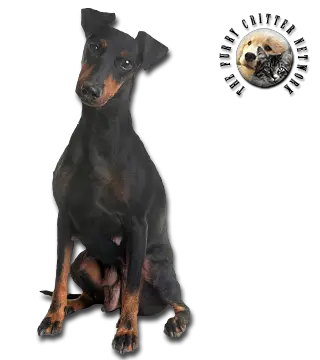Breed Standard
Head: Long and tight skinned. Flat, narrow, wedge-shaped skull. Muzzle tapers toward the nose. Tight lips.
Ears: Small, v-shaped, carried well above the level of the head and falling forward toward the eyes.
Eyes: Small, almond-shaped. Dark color.
Body: Short. Fairly long neck without dewlap. Chest is narrow between the legs and deep in the brisket. Ribs well sprung. Belly tucked up.
Tail: Short, thick at the root and tapering toward the tip. Carried slightly below the level of the back.
Hair: Short, smooth, dense; not soft.
Coat: Jet black and rich mahogany tan. Separation of colors must be clearly demarcated. Muzzle, jaws, throat, body extremities and inside of the forelegs are tan. Small tan spot on each cheek and above each eye. The nasal bone, body and feet must be jet black.
Size: Dog : 39 to 42 cm (15,5-16,5 in).Bitch : 37 to 40 cm (14,5-15,7 in).
Weight: 7,5 to 8 kg (16,5-17,7 lb).
History
The Manchester Terrier is the oldest known terrier breed. Developed as a rat hunter in nineteenth century Manchester, England by a man named John Hulme, it has earned the nickname of "rat terrier" because of its tenacity at catching rats and mice. It is considered to be the best vermin hunting breed. The Manchester Terrier was developed by crossing the Manchester Terrier and the Whippet. There are two types of Manchester Terrier: Standard and Toy. The Toy variety became popular during the reign of Queen Victoria, when smaller dogs were very popular. The Standard Manchester still retains the ability to be a prized ratter, but the breed as a whole is a companion dog. The Manchester Terrier has gone down in popularity. The Manchester Terrier was used in the development of several breeds, among them the Doberman Pinscher, and the Airedale Terrier.
Behavior
This robust, hardy, courageous dog is eager, fast and rather obstinate, though he is a cheerful, affectionate pet. The Manchester Terrier requires firm training.
The Manchester Terrier adjusts well to life as a house dog. Daily brushing is required.
Function
This breed is a good ratter. Guard Dog, Pet.
Health
Some are prone to a bleeding disorder called Von Willebrand's disease, but this is rare and wounds heal quickly. If left out in the sun for long periods, heat bumps may appear along its back.
At the end of the Second World War in 1945 there were only 11 Manchester Terriers registered with the Kennel Club, but thanks to the efforts of the British Manchester Terrier Club, formed in 1937, and others, the breed was saved from extinction. The Kennel Club has nevertheless classified the Manchester Terrier as a vulnerable native breed. Between 2010 and 2016, the last year for which data is available, an average of 164 births per year were registered.






